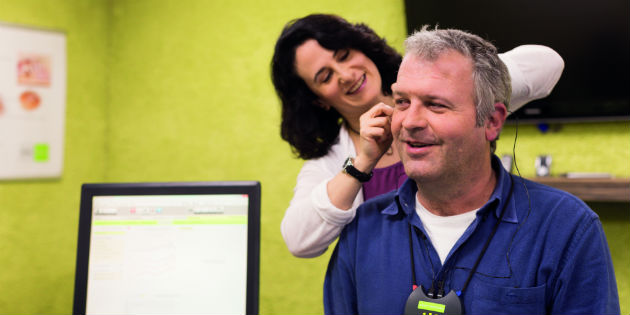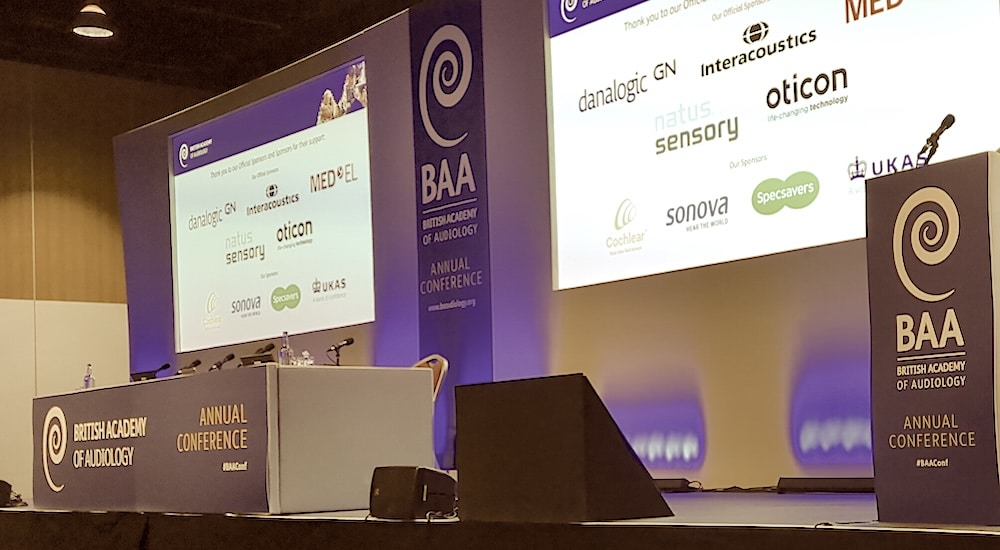Family-centered hearing care: Making a success of difficult conversations
Approach
In the last decade, family-centred care (FCC) hasbecome a successful model in healthcare, and isbecoming increasingly popular in the hearing aidsector.

Today we know that the family plays a centralrole in the health of affected people. This is why hearinginstrument wearers and those closest to them aremore and more included as partners on equal termsin the planning, implementation and assessment oftreatment. Studies have substantiated the numerousadvantages of this care approach. To ensure successfulimplementation in daily practice, it is important tobe aware that the affected person and his or herfamily do not always have the same perception ofthe hearing loss and its importance. When hearingaid specialists take this into account and apply a fewrecommendations in their discussions, all those involvedcan benefit from family-centred care.
Family-centred care is based on the recognitionthat a disease does not only affect those whohave the condition, but also those around them.As a result, it seeks to involve the family closelyin the care process. An expert panel broughttogether by Phonak under the leadership ofDr. Louise Hickson, Professor of Audiology and Headof the School of Health and Rehabilitation Sciences atthe University of Queensland, Australia, has developedspecific recommendations in this area for the hearingsector. The panel made use of current scientific insightsfrom family-centred care and practical experience inhearing rehabilitation, as well as knowledge from otherareas of healthcare.(1)
One family, multiple perceptions
In audiology, it is well known that hearing loss has negativepsychosocial consequences not only for affected peoplebut also for those around them.(2) These include necessarychanges in lifestyle, constraints in joint activities andcommunication difficulties, but also an emotional burdenrelated to the hearing loss of others. These negative psychosocial consequences also affect the perceptionof hearing loss by the family and what they expect fromhearing solutions. Here, the perspective of the familyis often quite different from that of the affected peoplethemselves. Through conventional patient care, hearingaid specialists are familiar with difficult discussions duringtheir dialog with affected people, for example when thereare reservations about hearing devices or unrealisticexpectations of what can be achieved. If a family memberjoins the discussion, there is even greater complexity. Whathappens if the affected person and the family membercontradict each other? What if there are reproaches fromeither side, or even an open argument? Or if the familymonopolizes the discussion and the affected personsimply takes a back seat? In this context, it may appeartempting not to integrate the family in the discussion atall, to avoid complicating things unnecessarily. However,it would be unfortunate not to involve the family fromthe outset because family-centred care offers multipleopportunities and advantages.
An important recommendation when implementingfamily-centred care in an audiology practice is to indicateat the start of the appointment that the opinions of thehearing aid wearer and of the family are needed. If theaffected person and the family perceive the situation inthe same way, and are both open to help from the hearingaid specialist, the consultation can go ahead and remainon target. If this is not the case, you might quickly get theunpleasant feeling that you have opened Pandora’s Boxwhen engaging in a three-way discussion in which bothsides are asked about their views of the hearing loss andthe use of hearing aids.(3)
Family matters (4)
An example in practice: a son believes that his fatherurgently needs a hearing solution but the father explainsduring the initial joint appointment with the audiologist thathe hears perfectly well for his age and only came along tothe appointment because his son had been insisting forages… The son takes a deep breath and launches into thecorresponding response… In this moment, it may seemadvisable just to concentrate on the father and to try andprovide him with a hearing test with clear results, with aview to offering a hearing solution.(5) This may well savetime and avoid conflict but the father will probably notchange his mind at the end of the appointment becausehe wouldn’t want to admit to the hearing loss in front ofhis son when he had been denying it for so long. Eventhough it may seem more efficient to avoid the tension inthe room by directly switching to problem-solving mode, itis important to remember that in difficult conversations infamily-centred care, it is always about feelings(6) and that it iscounter-productive to ignore this. Only when the concerns,reservations, expectations and wishes of all those involved in the discussion have been addressed will the hearingaid wearer and the family feel adequately informed andsatisfied with the result. Therefore, in this type of dialog,the goal should always be to help the father find a way tosee the situation differently and if possible from his son’sperspective. So it is essential that the audiologist not onlytalks to the father and then the son, but that he or shegets them to talk to each other. One strategy might be toask the father and the son what they like to do together asa family. This may help to rapidly bring the conversation to the things that no longer take place or that are limitedbecause the father can no longer hear so well. By diggingdeeper, it might be possible to help the father to acceptthat his son is suffering from the situation because healways enjoyed the time spent together, and that he didn’tinsist on his father coming to an appointment with anaudiologist because he is irritated, but rather becausehe would like to have more family time again.
Choosing the right strategy
In the example above, four different strategies are available tothe audiologist to confidently overcome difficult conversationsand to achieve a positive outcome (4):
1) It is better not to ignore the emotions in the room, evenwhen it may seem tempting to stay in your comfort zoneand not pay attention to the tension between the affectedperson and their family, and to focus on core competencies,i.e. the hearing test and guidance concerning the results.Also, this is a valuable occasion to win the client and theirfamily’s trust by being proactive in dealing with tensionand how people are feeling.
2) Use open-ended questions to bring both sides to acommon sharing process, for instance by asking thefamily what they like to do together. The initial answersmay not involve challenging hearing situations directly, butthese will come up of their own accord as the discussiongets going.
3) Give the family the chance to reformulate how theyfeel about the situation. Family members most oftenconcentrate on the things that frustrate them during the appointment, such as how loud the TV is or frequentmisunderstandings. And this can lead to mutual accusations.It should be made clear that the idea is not to lay blamebut rather to show that family life is suffering because ofthe reduced hearing and that the family is looking for asolution. This perspective may help the affected person tobetter understand the family’s point of view and motivatehim or her to consider a hearing solution.
4) Take a step back, even if you get the impression thatyour clients expect you to fill in the gaps during the dialog.When one or both of the people you are talking to make eyecontact with you, indicating that they want you to intervene,it may be worthwhile to pause briefly before joining thediscussion again. Often, there is still more that needs tobe expressed, even if the client and accompanying personneed some time to reflect and get their thoughts in order.If you avoid intervening immediately, there will often befurther dialog that can lead to mutual understanding anda common perspective on the situation.
The family is the patient
Of course, not all families are close and have a realinterest in supporting the affected person. In difficultfamily contexts, audiologists are advised to remain withinspecific boundaries because they are naturally not familycouncellors. (7) However, since it is rare that there is absolutelyno family in the broad sense that is interested in supportingthe affected person along the path of hearing rehabilitation,and since the benefits of family-centred care have beenclearly demonstrated (12), the main goal should generallybe to involve those who are close to the affected personin the care process.
Based on experience from family-centred care, to havethe best chances of conducting a positive assessmentand providing a beneficial hearing system, it is best toheed the following advice that is central in paediatricaudiology: the family is the patient.(9)(11) After an appointmentor a fitting session, this means asking whether the familyfeels well understood, whether the family is satisfied, andwhether the family is getting along well with the newsituation. This approach admittedly requires a certain shiftin mentality and handling difficult conversations calls for new abilities. According to Browning et al.(12), audiologistsmust recognize their own shortcomings and vulnerabilityto be able to deal confidently with an unwanted courseof conversation. They must also prepare for uncertaintyand increased complexity in their dialog with clients andtheir families. This increased awareness of the emotionalaspects of hearing rehabilitation, along with the technicalones, may seem a challenge at first. But experience has shown that it is possible to systematically feel at ease evenduring difficult conversations, and to channel thiseffectively.(13)(15) We are convinced that it is worthwhile tobecome engaged in these aspects and to acquire theseabilities, because when the hearing aid user and the familyare equally satisfied, the whole care process runs better.And in the end, the affected person is more likely to decideon a hearing solution.
References :
2. Scarinci N, Worrall L, Hickson L. The effect of hearing impairment in older people on the spouse development and psychometric testing of the significant other scale forhearing disability (SOSHEAR). Int J Audiol. 2009;48:671-683.
3. Martin E, Mazzola N, Brandano J, Luff D, Zukarowski D, Meyer E. Clinicians recognition and management of emotions during difficult healthcare conversations. PatientEducation and Counselling. 2015;98;12248-1254
4. Kris English et al Working with Difficult Conversations. Hearing review, 23(8):14.
5. Grenness C, Hickson L, Laplante-Levesque A, Meyer C, & Davidson B. Communication patterns in audiological history-taking: Audiologists, patients and their companions. EarHear. 2015;36(2):191-204.
6. Stone D, Patton B, Heen S. Difficult Conversations: How to Discuss What Matters Most. NY: Viking Press;1999.
7. Clark J, English K. Counseling-infused Audiologic Care. Boston: Allyn & Bacon;2014.7 Mahoney CFO, Stephens SDG, Cadge BA. Who prompts patients consult about hearingloss? Brit J Audiol. 996;30(3):153-158.
8. Institute of Medicine. Crossing the Quality Chasm: A New Health System for the 21st Century. Washington, DC: National Academy Press;2001.
9. Harrison M. Facilitating communication in infants and toddlers with hearing loss. In: Seewald R, Tharpe AM, eds. Comprehensive Handbook of Pediatric Audiology. SanDiego: Plural Publishing;2016: 829-847.
10. Allmond B. The Family is the Patient: Using Family Interviews in Children’s Medical Care. Baltimore: Williams and Wilkins;1999
11. Meyer E et al. Difficult conversations: Improving communication skills and relational abilities in health care. Pediatric Critical Care Med. 2009;10(3):352-359.
12. Browning DM, Meyer EC, Troug RD, Solomon MZ. Difficult conversations in health care: Cultivating relational learning to address the hidden curriculum. Medical Education.2007;82:95-113.
13. Back AL, Arnold RM, Baile WF, Tulsky JA, Fryer-Edwards K. Approaching difficult communication tasks in oncology. Cancer Journal for Clinicians. 2005;55:164-177.
14. Epner D, Baile W. Difficult conversations: Teaching medical oncology trainees communication skills one hour at a time. Academic Medicine. 2014;89(4).
15. Meyers L. Counseling today: All in the family. September 2014. Available: http://ct.counseling.org/2014/09/all-in-the-family
Photo: Phonak
 Sign in
Sign in

